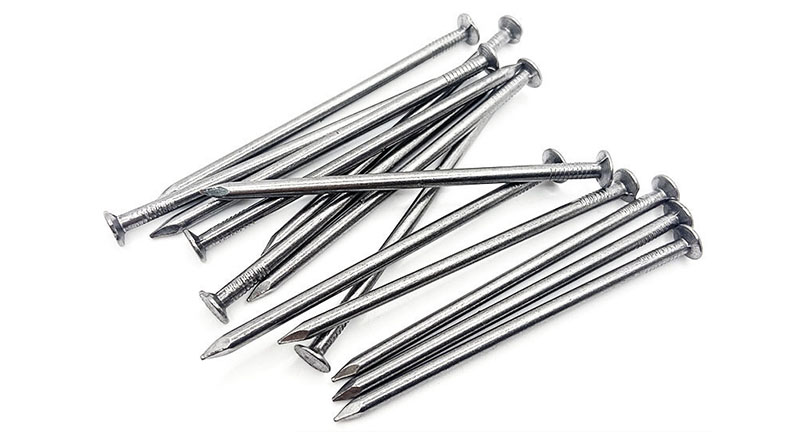Cement Nails vs. Iron Nails: Understand the Core Differences to Choose the Right Nail
In decoration construction, furniture assembly, or daily DIY projects, nails are indispensable basic fasteners. However, many people confuse cement nails with iron nails. Using them blindly may not only cause the nails to bend or break but also damage the base material and affect the construction effect. In fact, these two types of nails have completely different design purposes and performance characteristics. Only by clarifying their core differences can you select them accurately for different scenarios.
I. Essential Difference: Material Determines "Hard Strength"
The core difference between the two types of nails lies in their material selection, which directly determines their hardness, toughness, and application range. This is the fundamental prerequisite for distinguishing between them.
1. Cement Nails: "Tough Guys" Born for "Hard Environments"
Cement nails, also known as concrete nails, are mainly made of high-carbon steel or alloy steel and undergo professional heat treatment processes (such as quenching and tempering). The combination of this material and process gives cement nails extremely high hardness — their Rockwell hardness can usually reach above HRC 50, and some high-strength models can even exceed HRC 60.
High hardness endows cement nails with two key capabilities: first, they can withstand the violent impact of a hammer without bending easily; second, relying on their sharp tips, they can form effective penetration on the surface of hard base materials and break through the dense structure of materials such as concrete and bricks. However, excessively high hardness also leads to poor toughness of cement nails. If the striking angle is improper or the force is too strong, the tip may crack.
2. Iron Nails: "Flexible Players" Adapted to "Soft Scenarios"
The iron nails we usually refer to are actually mostly low-carbon steel nails (with a carbon content of less than 0.25%), and some low-end models even use pure iron materials. The hardness of such materials is much lower than that of cement nails, with a Rockwell hardness usually only between HRC 20-30, which is only about half of the hardness of cement nails.
But low hardness also brings advantages: iron nails have stronger toughness. When subjected to external impact, they are more likely to undergo slight deformation rather than break directly. This characteristic makes them very suitable for matching with soft base materials such as wood and gypsum boards — they can not only fit the texture of the base material through their own flexibility but also avoid wood cracking due to excessively high hardness. At the same time, they are easier to adjust during disassembly, reducing secondary damage to the base material.
II. Scenario Division: Efficiency Comes from Using the Right Nail in the Right Place
The difference in materials directly determines the "applicable battlefields" of the two types of nails. Choosing the wrong scenario will not only reduce construction efficiency but also may cause safety hazards.
1. Cement Nails' "Main Battlefield": Hard Base Materials
Cement nails are designed to cope with "hard environments", and their core application scenarios revolve around high-density and high-hardness base materials. Common scenarios include:
Wall Fixing: Hanging photo frames, decorative paintings, storage racks, and other light objects on concrete walls, brick walls, and stone walls without pre-drilling holes (some high-strength cement nails can be directly fixed by tapping);
Infrastructure Assistance: Fixing wire troughs and pipeline supports on cement floors and tile floors, or installing small hardware on outdoor concrete fences;
Special Needs: Temporarily fixing metal components, glass frames, etc. during decoration, using their high hardness to ensure fixing stability.
It should be noted that if the base material has extremely high hardness (such as a reinforced concrete load-bearing wall), directly using cement nails may cause the nails to crack. In this case, it is recommended to first use a hammer drill to drill a small hole with a diameter slightly smaller than the nail, and then insert the cement nail for fixing. This can not only protect the nail but also improve the fixing effect.
2. Iron Nails' "Comfort Zone": Soft Base Materials
The toughness advantage of iron nails makes them the "best partner" for soft and porous base materials. Their main application scenarios are concentrated in:
Wood Processing: When making wooden furniture, splicing wooden boards, and fixing wooden keels, iron nails can penetrate the wood fibers and bite firmly, avoiding wood cracking caused by nails with excessively high hardness;
Interior Decoration: Fixing keels and hanging strips on lightweight partition walls such as gypsum boards and calcium silicate boards, or fixing on thin wooden components such as furniture backboards and drawer bottom boards;
Daily DIY: Hand-making wooden storage boxes, assembling toys, or auxiliary fixing in wall soft packs and fabric decorations, which can not only ensure stability but also not damage the appearance of the base material.
In addition, some iron nails undergo surface treatment (such as galvanizing and chrome plating) to improve rust resistance. Such rust-proof iron nails can also be used in mild outdoor scenarios such as outdoor wooden fences and flower racks, but long-term contact with rainwater or humid environments should be avoided.
III. Detailed Comparison: Comprehensive Differences from Appearance to Usage
In addition to the core differences in materials and scenarios, the differences between the two types of nails in details such as appearance, tool matching, and cost also affect the actual use experience. These details are often key points that novices easily overlook.
Comparison Dimension | Cement Nails | Iron Nails |
Appearance Design | Mostly smooth and silvery white, with sharp and slender tips, and thick nail bodies (common diameter: 3-6mm). Some models have fine anti-slip lines on the nail bodies. | The surface is mostly dark brown (ungalvanized) or silvery white (galvanized), with blunt and short tips, and thin nail bodies (common diameter: 1-4mm). Some wood-use iron nails have threads (i.e., wood screws). |
Matching Tools | Need to be used with heavy claw hammers and rubber hammers, and the force should be uniform when striking; for hard base materials, a hammer drill (optional) is needed for cooperation. | Can be tapped lightly with a light hammer; threaded wood screws need to be used with a screwdriver (flathead/crosshead), and no high-strength tools are required. |
Fixing Effect | Bites tightly with hard base materials, not easy to loosen after fixing, but difficult to disassemble and easy to damage the base material. | Has good adhesion to soft base materials, low difficulty in repairing the base material after disassembly, but may slightly loosen under long-term force (regular inspection is required). |
Cost and Price | Complex materials and processes lead to a higher unit price, usually 2-5 times that of iron nails. | Ordinary materials and simple production result in a low unit price, suitable for bulk use. |
Safety Precautions | Wear gloves when striking to prevent scratches from cracked tip fragments; avoid forcibly striking load-bearing structures. | Avoid using on hard base materials to prevent injury from flying bent nails; galvanized iron nails should avoid contact with acidic substances (such as wood preservatives) to prevent corrosion. |
IV. Purchase and Usage: Guide to Avoid Pitfalls
In actual purchase and use, mastering the following skills can further improve efficiency and avoid mistakes:
Choose the Type Based on Needs: If the base material is "hard" (concrete, brick, stone), directly choose cement nails; if the base material is "soft" (wood, gypsum, fabric), prioritize iron nails, and there is no need to pursue high hardness;
Check Specifications Based on Scenarios: Cement nails are divided into lengths of 30mm-100mm; short nails are suitable for hanging light objects, and long nails are suitable for fixing heavy objects. Iron nails are divided into ordinary round nails, wood screws, and tack nails according to their uses; choose threaded wood screws for better fixing effect;
Use the Right Tools for Safety: Use a heavy hammer to strike cement nails with uniform force; use a light hammer to strike iron nails to avoid bending the nails due to excessive force;
Pay Attention to Rust Prevention Needs: For outdoor or humid environments (such as bathrooms and kitchens), choose galvanized cement nails and hot-dip galvanized iron nails to extend their service life.
In short, there is no "superior or inferior" between cement nails and iron nails, only "adaptation differences". Remember the core principle of "using cement nails for hard base materials and iron nails for soft base materials", and then adjust the specifications and usage methods according to specific scenarios. In this way, you can make the small nails play the greatest role and make the construction more efficient and safe.



 Send Email
Send Email